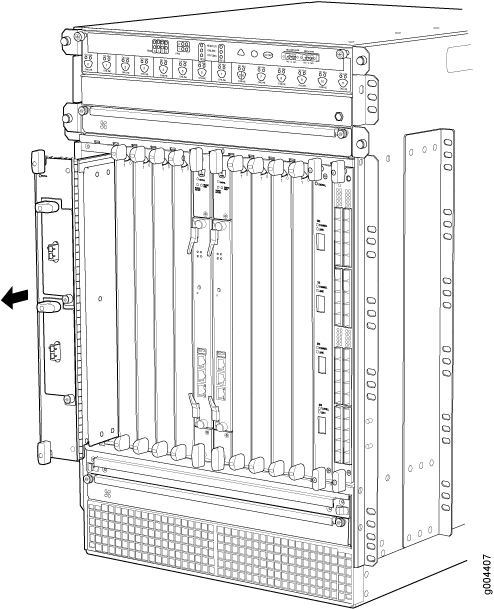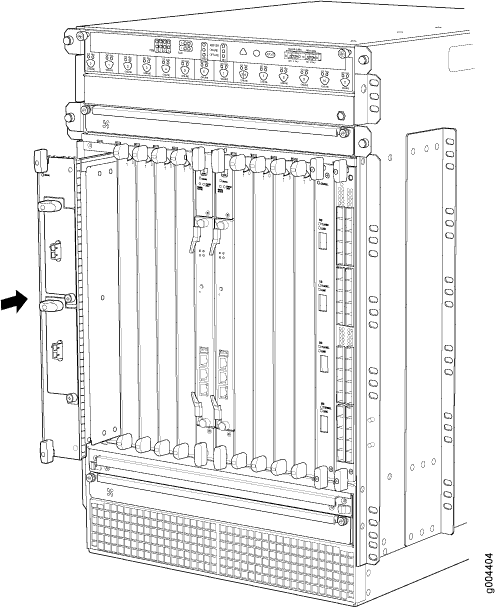ON THIS PAGE
Replacing an MX960 FPC
Removing an MX960 FPC
When you remove an FPC, the router continues to function, although the PIC interfaces installed on the FPC being removed no longer function.
An FPC takes up two DPC slots on the MX960 router. Up to six FPCs can be installed vertically in the front of the MX960 router. The FPCs are hot-insertable and hot-removable. An empty FPC3 weighs 14 lb (6.5 kg). A fully configured FPC can weigh up to 18 lb (8.2 kg). Be prepared to accept its full weight.
To remove an FPC (see Figure 1):
- Have ready a replacement FPC or FPC blank panel and an antistatic mat for the FPC. Also have ready rubber safety caps for each PIC using an optical interface on the FPC that you are removing.
- Attach an ESD grounding strap to your bare wrist, and connect the other end of the strap to an ESD grounding point.
- Label the cables connected to each PIC on the FPC so that you can later reconnect the cables to the correct PICs.
-
Use one of the following methods to take the FPC offline:
-
Press and hold the FPC online/offline button. The green OK LED next to the button begins to blink. Hold the button down until the LED goes out. The LEDs and online/offline button for each FPC are located directly above it on the craft interface.
-
Issue the following CLI command:
user@host>request chassis fpc slot slot-number offlineFor more information about the command, see the CLI Explorer.
Note:The slot number corresponds to the lowest numbered slot for which the FPC is installed.
-
-
Disconnect the cables from the PICs installed in the FPC.
Laser Warning:
Do not look directly into a fiber-optic transceiver or into the ends of fiber-optic cables. Fiber-optic transceivers and fiber-optic cables connected to a transceiver emit laser light that can damage your eyes.
CAUTION:Do not leave a fiber-optic transceiver uncovered, except when inserting or removing a cable. The safety cap keeps the port clean and protects your eyes from accidental exposure to laser light.
CAUTION:Do not bend a fiber-optic cable beyond its minimum bend radius. An arc smaller than a few inches in diameter can damage the cable and cause problems that are difficult to diagnose.
- If a PIC uses fiber-optic cable, immediately cover each transceiver and the end of each cable with a rubber safety cap. Arrange the disconnected cables in the cable manager to prevent the cables from developing stress points.
- Simultaneously turn both the ejector handles counterclockwise to unseat the FPC.
- Grasp the handles, and slide the FPC straight out of the card cage halfway.
-
Place one hand around the front of the FPC (the PIC housing)
and the other hand under it to support it. Slide the FPC completely
out of the chassis, and place it on the antistatic mat or in the electrostatic
bag.
CAUTION:
The weight of the FPC is concentrated in the back end. Be prepared to accept the full weight—up to 18 lb (8.2 kg)—as you slide the FPC out of the chassis.
When the FPC is out of the chassis, do not hold it by the ejector handles, bus bars, or edge connectors. They cannot support its weight.
Do not stack FPCs on top of one another after removal. Place each one individually in an electrostatic bag or on its own antistatic mat on a flat, stable surface.
- If necessary, remove each installed PIC from the FPC.
- After you remove each PIC, immediately place it on an antistatic mat or in an electrostatic bag.
-
If you are not reinstalling an FPC into the emptied DPC
slots within a short time, install a blank DPC panel over each slot
to maintain proper airflow in the card cage.
CAUTION:
After removing an FPC from the chassis, wait at least 30 seconds before reinserting it or inserting an FPC into a different slot.

Installing an MX960 FPC
An FPC takes up two DPC slots on the MX960 router. Up to six FPCs can be installed vertically in the front of the router. The FPCs are hot-insertable and hot-removable. An empty FPC3 weighs 14 lb (6.5 kg). A fully configured FPC can weigh up to 18 lb (8.2 kg). Be prepared to accept its full weight.
To install an FPC (see Figure 2):
- Attach an ESD grounding strap to your bare wrist, and connect the other end of the strap to an ESD grounding point.
- Place the FPC on an antistatic mat.
- Take each PIC to be installed in the replacement FPC out of its electrostatic bag, and identify the slot on the FPC where it will be connected.
- Verify that each fiber-optic PIC has a rubber safety cap covering the PIC transceiver. If it does not, cover the transceiver with a safety cap.
- Install each PIC into the appropriate slot on the FPC.
- Locate the two slots in the card cage in which you plan to install the FPC.
- Orient the FPC so that the faceplate faces you.
- Lift the FPC into place, and carefully align the sides
of the FPC with the guides inside the card cage.CAUTION:
When the FPC is out of the chassis, do not hold it by the ejector handles, bus bars, or edge connectors. They cannot support its weight.
- Slide the FPC all the way into the card cage until you feel resistance.
- Grasp both ejector handles, and rotate them clockwise simultaneously until the FPC is fully seated.
- If any of the PICs on the FPC connect to fiber-optic cable,
remove the rubber safety cap from each transceiver and cable.Laser Warning:
Do not look directly into a fiber-optic transceiver or into the ends of fiber-optic cables. Fiber-optic transceivers and fiber-optic cables connected to a transceiver emit laser light that can damage your eyes.
- Insert the appropriate cable into the cable connector ports on each PIC on the FPC.
- Arrange the cable in the standard or extended cable manager to prevent
it from dislodging or developing stress points. Secure the cable so
that it is not supporting its own weight as it hangs to the floor.
Place excess cable out of the way in a neatly coiled loop. Placing fasteners on the loop helps to maintain its shape.CAUTION:
Do not let fiber-optic cables hang free from the connector. Do not allow the fastened loops of a cable to dangle, which stresses the cable at the fastening point.
CAUTION:Do not bend a fiber-optic cable beyond its minimum bend radius. An arc smaller than a few inches in diameter can damage the cable and cause problems that are difficult to diagnose.
- Use one of the following methods to bring the FPC online:
Press and hold the FPC online/offline button until the green OK LED next to the button lights steadily, in about 5 seconds. The LEDs and online/offline button for each FPC are located directly above it on the craft interface.
Issue the following CLI command:
user@host>request chassis fpc slot slot-number online
For more information about the command, see the CLI Explorer.
CAUTION:After the OK LED lights steadily, wait at least 30 seconds before removing the FPC again, removing an FPC from a different slot, or inserting an FPC in a different slot.
You can also verify correct FPC and PIC functioning by issuing
the show chassis fpc and show chassis fpc
pic-status commands described in Maintaining MX960 FPCs and Maintaining MX960 PICs.

